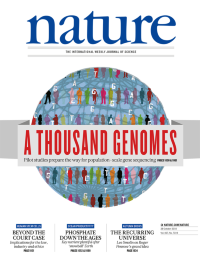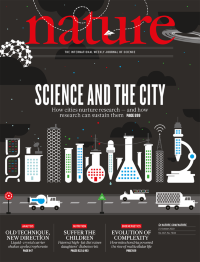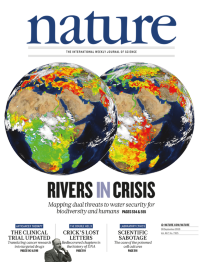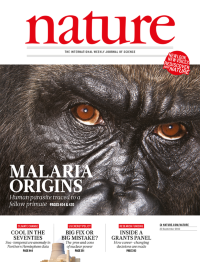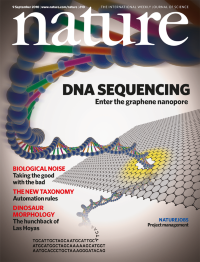Volume 467
-
No. 7319 28 October 2010
This issue of Nature contains the first publication of the results from the pilot phase of The 1000 Genomes Project, an international collaboration that will produce an extensive public catalogue of human genetic variation. The plan, in fact, is to sequence about 2,000 unidentified individuals from 20 populations around the world. Cover credit: Andy Martin.
-
No. 7318 21 October 2010
More than half of the global population lives in cities. This press of people is a breeding ground for some of the worlds greatest problems: pollution, poverty, disease and crime. Yet humankind is sometimes at its best in cities - and, as the series of News Feature and Comment pieces in this issue demonstrates, science is important to cities and cities to science. Cover credit: Oliver Munday.
-
No. 7317 14 October 2010
A language-based phylogeny of Austronesian societies has been used to test competing models of how complex societies rise and fall. The findings suggest that whereas increases in complexity tend to be stepwise, large decreases may be possible. On the cover, a 1776 oil painting titled Review of the War Galleys at Tahiti by artist William Hodges, who travelled with explorer James Cook on his second voyage to the Pacific Ocean. Credit: National Maritime Museum/Ministry of Defence Art Collection.
Nature Outlook
-
No. 7316 7 October 2010
Despite living in a disk galaxy, we have a very poor understanding of how they form. Many of the disk galaxies of the early Universe are surprisingly large and far more turbulent than the Milky Way and other modern spirals. Now the discovery of a sample of 'turbulent disk' galaxies persisting to the present adds a new element to the debate. Their properties suggest that star formation is the energetic driver of galaxy disk turbulence at all cosmic epochs. The GIMIC (Galaxies-Intergalactic Medium Interaction Calculation) simulation on the cover shows a flow of cold gas (in red) feeding star formation that then drives turbulent outflows (in blue). Cover credit: Rob Crain, James Geach, Andy Green and Swinburne Astronomy Productions
-
No. 7315 30 September 2010
The security of water supply for humans and the biodiversity of rivers are often seen as competing goals, but need that be the case? A new global-scale analysis of freshwater resources advances the field by considering threats to both river biodiversity (on the left on the cover) and to human water security, after accounting for investments in infrastructure and water services (right). The maps reveal that the worlds rivers are in a state of crisis. Achieving a sustainable solution to these problems, the authors say, will require strategies that jointly address water security for humans and biodiversity. COVER CREDIT: Stanley Glidden
-
No. 7314 23 September 2010
The evolutionary origin of the human malaria parasitePlasmodium falciparum has been traced to a fellow primate, probably the result of a single host transfer event. Genetic analysis of thousands of fecal samples from African apes shows that the parasites from western gorillas rather than those in chimpanzees or bonobos are most closely related to the human form. The cover shows a western lowland gorilla. Picture credit: George Logan/Corbis
-
No. 7313 16 September 2010
Through a process known as the glacial buzzsaw, glaciers can act as powerful erosive agents, inhibiting the ability of active mountains to rise significantly above the elevation of permanent glaciation. Now a study of erosion patterns and climate data from the late Cenozoic in the glaciated Patagonian Andes suggests that glaciation can also make mountains higher. At polar latitudes, a glacial layer can protect uplifting mountains from erosion, allowing them to reach heights well above those predicted had a glacial buzzsaw been active. On the cover, the 3,130-metre-high peak of Cerro Torre seen from Laguna Torre. Photo: Richard IAnson/Lonely Planet Images.
-
No. 7312 9 September 2010
Researchers from Harvard University and the Massachusetts Institute of Technology show that graphene, when used as a membrane to separate two liquid reservoirs, is strongly ionically insulating yet its in-plane electronic properties are strongly dependent on the environment on each side of the membrane. Various analytical applications may result from this behaviour. For instance, if pores measuring a few nanometres in diameter are drilled into these trans-electrode membranes, a long DNA molecule can be threaded through the graphene nanopore; the way in which the molecule behaves as it squeezes through offers a potential basis for DNA-sequencing devices that are far less expensive to operate than current machines. Illustration: Paul Montie Design.
-
No. 7311 2 September 2010
The spread of antibiotic-resistant bacteria is a growing threat in clinical environments, but the process by which they arise is not well understood. Experiments using a continuous culture of Escherichia coli exposed to an antibiotic show that a few spontaneous drug-resistant mutants can protect the majority of the population by producing the signalling molecule indole. This activates drug efflux pumps and other protective mechanisms in susceptible kin. More work on the use of intracellular communication by bacteria may prove of value in the rational design of clinical interventions to control resistant bacterial infections. Cover credit: Red cross, created digitally by David Ascano, Henry Lee, Michael Molla and James Collins.

